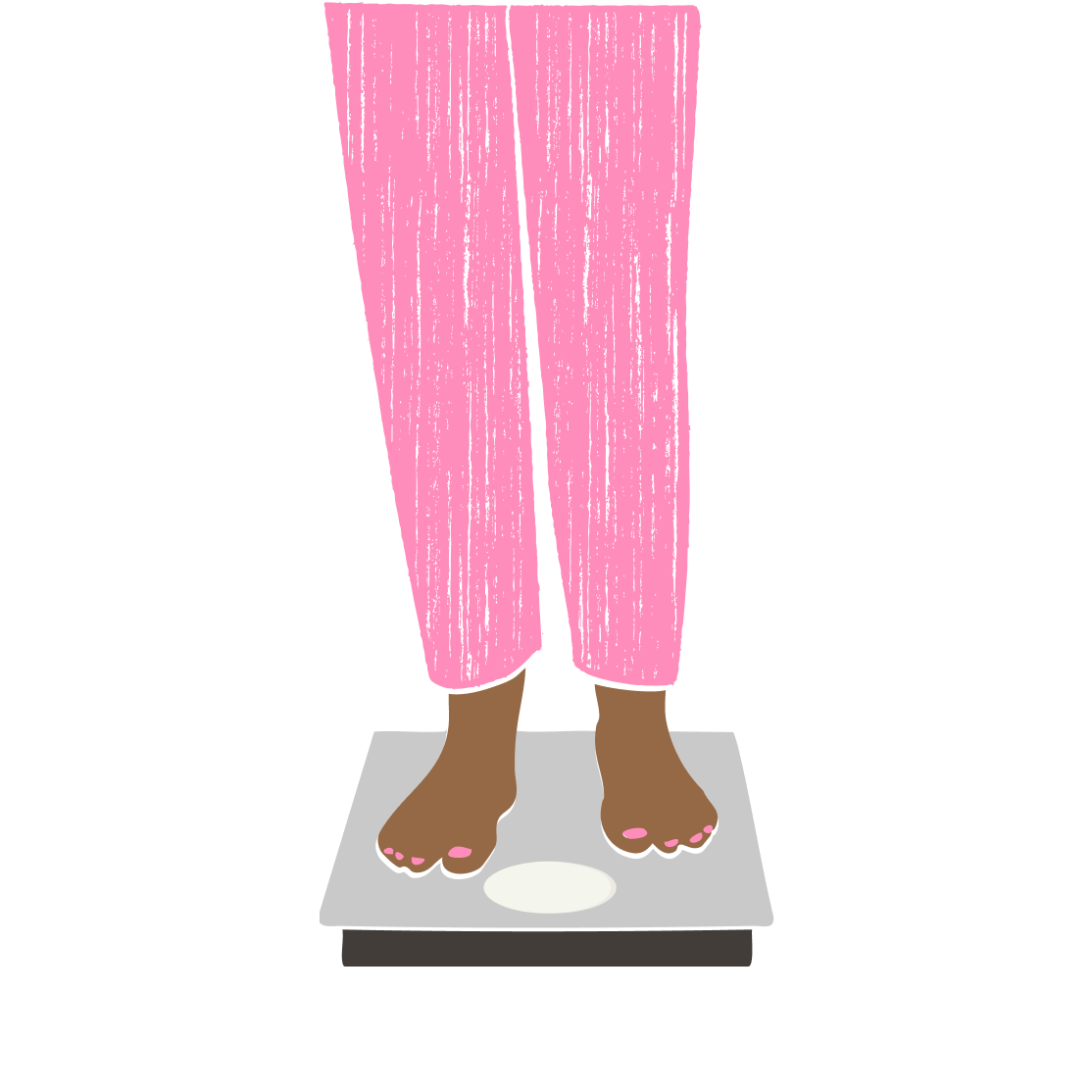Semaglutide has become a popular option for weight loss, including for those dealing with menopause-related weight gain. Combining hormone replacement therapy (HRT) with semaglutide may improve weight reduction while also helping manage menopause symptoms—a win-win for many patients. However, these medications aren’t a magic bullet—and everyone may have side effects. Consulting a menopause-trained clinician can help you explore whether semaglutide, HRT, or lifestyle changes are the best fit for your needs.
Semaglutide and Menopause: Menopause Weight Loss Medication
If you’re in your 30s, 40s, or 50s and on social media, your feed is likely filled with content focusing on two hot topics: weight loss medications like semaglutide, and menopause. The algorithms are on to something real: Women gain an average of 1.5 pounds per year in midlife; a study published in the International Journal of Obesity cited an average weight gain of 12 pounds within eight years of hitting menopause. So there’s a good reason women in menopause might have weight (along with hot flashes, insomnia, and dozens of other symptoms of hormone change) on their minds.
It’s not just extra pounds, but also where that fat is stored that changes in perimenopause (the years before your period stops) and menopause. Women often see more accumulating around the midsection or waist as opposed to the thighs and butt. In fruit terms, pear figures find themselves shapeshifting to more of an apple vibe.
Nearly 90% of Midi patients report weight gain and body changes in midlife. “Women tell me they haven’t changed their eating habits or exercise routine, but suddenly they have this weight gain that they can’t explain,” says menopause specialist Gisele Thissen, MSN, FNPC, NCMP, a clinician at Midi Health. The ramifications of midlife weight gain extend far beyond aesthetics, contributing to an increased risk of heart disease, type 2 diabetes (T2D), and other metabolic disease. (That said, aesthetics—and their impact on confidence and body image—certainly matter to many women.)
But you don’t need to just sit back and accept weight gain as yet another inevitable part of the sands of time. There are a range of options for managing perimenopausal and menopausal weight gain. Beyond the usual education on topics like portion control and mindful eating, it may be time to discuss options including hormone therapy and prescription weight loss medications. These are both incredibly effective at quieting “food noise” (a term recently used by Oprah Winfrey to describe the intrusive mental chatter that can make it hard to follow a healthful nutrition plan), dampening appetite while improving cardiometabolic health (which is a measure how how well your entire cardiovascular and metabolic systems are functioning)
Below, we get into menopause weight loss medication and semaglutide, the star ingredient in FDA-approved prescription weight loss medications like Ozempic, Wegovy, and Zepbound. Using semaglutide for menopause weight gain is a practice that researchers and medical providers believe may hold huge promise for helping midlife women reach and maintain a healthy weight. And don’t worry, we’ll unpack everything about semaglutide and menopause, including how the drug works, possible side effects, and why it’s becoming increasingly popular in the midlife women demographic.
Why Weight Gain During Menopause is So Common
To understand how semaglutide-containing medications like Ozempic and Wegovy can lead to such dramatic weight loss it helps to have a grasp on why menopausal weight gain happens in the first place.

Chances are you’ve been taught that healthy weight maintenance boils down to a simple “Calories in < Calories out” equation, meaning that all you need to do to avoid weight gain is burn more calories than you take in.
In reality, weight gain and loss are far more nuanced. Calories do matter, but many other factors are at play.
Factors that Influence Midlife Weight Gain

An Aging Metabolism
Everyone loses muscle as they age; women, in particular, lose 3-5% of their muscle mass per decade starting in their 30s, with that loss only accelerating after menopause. Why does that matter? Muscle is heavier than fat and metabolically active, meaning “it requires more energy simply to sustain it,” says Tonya Prather, NASM-CPT, a certified personal trainer and Fitness Director at The Nelson Golf & Sports Club in Irving, Texas. “So the more muscle you have, the more calories your body burns to move you around, or even simply to rest.” Muscle is metabolically active, meaning your body must work to sustain it. Hence, the popular fitness trainer wisdom about “The more muscle you have, the more calories you burn, even at rest.” Unless you strength-train and take other steps to counteract age-related muscle loss, you can expect to lose 4 to 6 pounds of muscle per decade.
What replaces that precious, metabolically active muscle? You guessed it: “fat.” The substitution of muscle with fat that so often accompanies aging makes itself known in many ways, including (but not limited to) a slowed metabolism. And when this recalibration occurs against a backdrop of hormone disruption, that fat often settles in the abdomen, creating what many women call “meno belly.”
The loss of muscle mass and increase in fat mass translates to more than weight gain. Because muscle is a critical player in blood sugar regulation, midlife muscle loss often goes hand-in-hand with insulin resistance, a common condition in which cells lose the ability to efficiently usher glucose out of the bloodstream to burn for energy. That inefficiency paves the way for chronic health conditions like high blood pressure and type 2 diabetes, as well as further hormone disruption and weight gain. “With rising insulin levels and blood sugar levels, our bodies will begin to store excess sugar as fat,” says Midi’s Chief Medical Officer, Kathleen Jordan, MD.
Hormonal changes
When it comes to hormones that help us build muscle and hang on to it, testosterone gets much of the credit, but estrogen is equally important. One of estrogen’s many superpowers: the ability to maintain women’s muscle mass and strength. Estrogens help maintain muscle strength in women by preserving muscle mass and keeping the proteins responsible for muscle contractions healthy. They also play a role in helping the muscle fibers generate force by improving the way key proteins interact.
As estrogen levels embark on their downward rollercoaster throughout perimenopause, muscle mass maintenance becomes more and more challenging. The delicate balance of estrogen and testosterone that exists pre-menopause tends to keep body fat in the lower body, away from the belly, so the midlife estrogen dip can leave women perplexed and upset when their pants no longer button—even if they’re still eating well and exercising.
Estrogen also helps regulate appetite. Despite its reputation for sparking chocolate cravings during certain times of the month, estrogen generally has an appetite-dampening effect. For instance, women tend to eat less as they approach ovulation, and find it harder to resist cravings during perimenopause, when estrogen and other sex hormones are in flux.
One reason this happens is that the Big E has a hand in modulating two critical hunger-modulating hormones: ghrelin, which can rev up food intake, and leptin, the satiety (aka fullness) hormone. When estrogen levels dip in perimenopause, ghrelin levels rise and, as a result, so do appetite, cravings for carbs, sweets, and fast food, and the accumulation of belly fat.
Lack of sleep
The fallout from insomnia and night sweats extends long after the overnight hours. “Poor sleep is linked to weight gain as it can result in exhausted days—so you may avoid exercise and reach for carbs to give you quick energy,” says Dr. Jordan. “Both hormone changes from menopause and mid-life stressors contribute to poor sleep.” Poor quality sleep can also increase ghrelin.
Stress
It’s no surprise that the many demands of midlife, including job pressures, financial strain, and caring for children and possibly aging parents, can make this a psychologically grueling stretch of time. Cortisol, the chief stress hormone released when we’re under the gun, triggers emotional eating and interferes with blood sugar regulation, tipping you towards insulin resistance.

Why Does Weight Loss Feel So Complicated?
Losing weight is hard, full stop. It’s not a matter of willpower or desire; once the weight is there, the body puts up a surprisingly strong fight to hang on to it, driven by evolutionary forces that equate weight loss with starvation and the death of the human species. (Wow, way to be dramatic, DNA.) While some people can shed smaller amounts of weight solely via lifestyle tweaks like eating less, moving more, and getting more sleep-–about 5 to 10% of one’s baseline weight, or about 9 to 18 pounds for a 175-lb person—only a tiny percentage of us can successfully lose larger amounts of weight using these strategies alone.
As recently as a few years ago the main options to support major weight loss were somewhat limited: physician-supervised nutritional interventions; weight loss surgery; prescription medications like phentermine (a powerful stimulant that works by decreasing hunger and cravings) and bupropion (an antidepressant that affects the appetite center of the brain). Even then, surgery and medication were unfairly stigmatized, seen as a crutch or last-ditch resort for people who “couldn’t” lose weight “on their own.”
The meteoric rise in popularity of anti-obesity medications (AOMs) like semaglutide and tirzepatide has reshaped the narrative, with more people embracing the pharmaceutical approach to weight loss.
Semaglutide 101

Semaglutide belongs to a class of medications called glucagon-like peptide-1 (GLP-1) receptor agonists. GLP-1 is a naturally-occurring hormone made in the small intestine. It helps lower blood sugar levels and slows the digestive process, so you feel fuller, longer. GLP-1 also works in the brain to silence food noise, further promoting a feeling of satiety. (Imagine: being able to stop at one cookie! No obsessing about what you’re going to eat and how you’ll resist temptation! To approach a meal without baggage!)
Doctors have used GLP-1 receptor agonists, which mimic the GLP-1 hormone, to treat T2D for almost 20 years. In 2017, the Food and Drug Administration approved a new iteration, Ozempic (semaglutide), as a T2D treatment; in 2021, a larger amount of semaglutide, rebranded as Wegovy, was FDA-approved for people with obesity or who are overweight and have health problems related to that excess weight. That’s when semaglutide started to become a household name and perpetual dinner table topic.
Its allure stems from its ability to help people lose significant amounts of weight.
In a seminal March 2021 New England Journal of Medicine study, adults receiving a weekly 2.4 mg injection of semaglutide for about 15 months lost 15% of their body weight—35 pounds, on average—compared to just 2.4% body weight loss in the placebo group. More than a third of subjects in the semaglutide arm of the study lost more than 20% of their weight; many subjects with T2D saw improvements in their blood sugar regulation, too. Subsequent studies have yielded similar success rates.
Understanding Semaglutide and Menopause-Related Weight Gain
Erica*, 48, from South Jersey, says no amount of calorie-cutting, hot yoga, or Pilates could budge the 12 pounds she acquired during perimenopause, much of it around the waistline. She also felt relatively powerless when it came to resisting the hormone-driven junk food cravings that popped up in her 40s.
“It’s not about knowing what to eat and not eat, or how to exercise—I have all the knowledge,” says the self-described health nut who ultimately turned to semaglutide to get back to her pre-menopausal weight. “For me, it’s about the mental real estate that’s been freed up in my brain, because I’m no longer thinking about food all the time.”
For Erica, less food noise has been semaglutide’s best perk.
Other benefits of combining semaglutide and menopause:
- It slows gastric emptying, or the rate at which food leaves the stomach, keeping you feeling fuller, longer. “Now, I can have a piece of pizza and be full, as opposed to eating two and a half pieces,” Erica says.
- It improves blood sugar control and insulin sensitivity. In the short term, women may notice improvements in energy and mood, both of which are influenced by insulin resistance. Long-term, improved insulin sensitivity often translates to a reduced risk of T2D, high blood pressure, heart disease, and other cardiometabolic disease, all of which grow more prevalent in midlife.
- Fewer hot flashes and night sweats. Losing weight may improve these quintessential menopause symptoms, though the effect seems to depend on where a woman is in her perimenopausal journey.
Combining Semaglutide with Hormone Therapy May Offer Even More of an Edge
While not typically prescribed solely for weight loss, Hormone Replacement Therapy (HRT) is linked with decreases in total fat mass and abdominal fat and improvements in insulin resistance and cholesterol levels. Hormone therapy may also help perimenopausal and menopausal women lose weight by easing vasomotor symptoms that affect sleep, such as insomnia and night sweats. Better sleep yields more energy for exercising, for instance, and helps regulate those appetite hormones, ghrelin and leptin.
Other research has linked HRT with an improved response to strength training, with early menopausal women wearing an estrogen patch showing significantly greater gains in muscle strength compared with those wearing a placebo patch.

New research suggests combining GLP-1 drugs like Ozempic and menopause hormone treatment may be even more beneficial. In a recent Mayo Clinic study, postmenopausal women who were overweight or had obesity and combined semaglutide and HRT experienced about 30% more significant weight loss than those using semaglutide alone. This doesn’t necessarily mean that HRT boosts semaglutide’s efficacy, the study authors proposed, but rather that not receiving HRT may weaken the post-menopausal body’s response to semaglutide. Lead study author Maria D. Hurtado Andrade, MD, also suggested HRT might make it easier to shed pounds by improving sleep and other quality-of-life measures. This is something Dr. Jordan is seeing in many Midi patients. “Being on hormone replacement therapy has helped more women have meaningful responses to these medications. While the study involved a small number of patients, it does reflect what we are seeing in practice at Midi.”
How to Use Menopause Weight Loss Medication, Plus Side Effects to Watch For
GLP-1 agonists are most commonly offered as injectables. They're usually self-administered weekly in the belly, outer thighs, buttocks, or the back of the arms. Oral semaglutide for weight loss is another option for those who don't want to do the shots. They are taken daily as a pill or sublingual drops placed under the tongue.
Brand-name formulations include Ozempic, Wegovy, and Rybelsus. At Midi, we offer compounded semaglutide, which contains the same active ingredient as name-brand semaglutide but can be more affordable and isn’t typically affected by drug shortages.
It’s reasonable to be concerned about side effects, though they can be controlled with careful guidance from a trained clinician. Up to half of patients deal with nausea, which tends to be mild or moderate and often eases up as treatment progresses.
Other common side effects of GLP-1 agonists:
- diarrhea or constipation
- abdominal pain
- belching, gas, or heartburn
- feeling bloated
- injection site reactions
- vomiting
Your clinician will offer you tips for managing side effects, as well as share common contraindications (reasons to not take semaglutide), including a personal or family history of medullary thyroid cancer or multiple endocrine neoplasia. Aromatase inhibitors, a common class of breast cancer medication, seem to limit the effectiveness of GLP-1 drugs, perhaps due to their anti-estrogen effects.
It’s worth noting that not much is known about the safety of semaglutide in pregnancy. If you haven’t yet hit menopause, be sure to use birth control while taking it. The weight loss facilitated by GLP-1 medications has led to improved fertility in many women, leading to a wave of “Ozempic babies.” (It may boost fertility in men, too, so if you have a male partner taking semaglutide, be on alert.)
Setting Women Up For Success
Using semaglutide for menopause weight gain isn’t a silver bullet for weight loss. It must be combined with lifestyle changes known to promote healthy weight management, like Mediterranean-style eating and strength training. Some people, like Erica, find their food noise silenced so entirely that they must make a concerted effort to remember to eat more.
“I’ll have my morning coffee, and then it could be 2PM, and I’ll realize, ‘Oh, I haven’t eaten yet,’” she says. She’s been working with her doctor to incorporate more protein, which can help combat the muscle loss that often accompanies significant weight loss. Bone loss can also occur while on semaglutide, or with any form of rapid weight loss. This is because bones strengthen in response to bearing weight; as the number on the scale drops, less pressure is exerted on the bones, which can weaken as a result. (This helps explain the somewhat counterintuitive protective effect of obesity against bone fractures and osteoporosis.) This makes strength training and aerobic exercise even more crucial. A 2024 JAMA Network Open study found that supplementing a GLP-1 receptor agonist with exercise (indoor cycling and circuit training, specifically) can help preserve bone strength. It’s also important to get adequate calcium and vitamin D while on GLP-1 medications.
Semaglutide is considered a long-term medication; many people use it for years to maintain their weight loss. But Thissen recommends reframing it as a stepping stone towards future health, so patients can “get their kickstart and develop healthy habits, so they lose the weight and don’t regain it.” Patients with smaller weight loss goals, Thissen adds, can consider using a lower-than-standard dose, something often called “microdosing” on social media. Once they reach their goals, Midi clinicians may taper patients down to a lower dose, and sometimes ease them off semaglutide entirely, depending on their individual needs. When patients do stop taking semaglutide for menopause weight gain, their Midi clinician can help them determine the best next steps. “Maintenance looks different for everyone,” Thissen says, and might include switching to a different type of weight loss medication, like metformin, or a dietary supplement, like berberine.
The Takeaway
- Semaglutide has become a popular weight loss medication for many people, and if you’re one of the many people coming face-to-face with menopause weight gain, you may be amongst them.
- There’s some evidence that combining hormone replacement therapy (HRT) with semaglutide can have beneficial effects on weight reduction, as well as menopause symptom management.
- Not everyone is a candidate for these weight loss medications, and they can have a range of side effects.
- Working with a skilled menopause-trained clinician can help you determine if using semaglutide is something you should consider. They can also recommend important diet and lifestyle changes.
If you’re in perimenopause or menopause and want guidance from clinicians who specialize in women’s midlife health, book a virtual visit with Midi today.
Hormonal change is at the root of dozens of symptoms women experience in the years before and after their period stops.
Our trained menopause specialists can help you connect the dots to guide you towards safe, effective solutions.
Whether you need personalized guidance or a prescription routine to tackle symptoms—including brain fog, hot flashes, sleep trouble, mood swings, and weight gain—we’ve got you covered.
Midi’s mission is to revolutionize healthcare for women at midlife, wherever they live and whatever their health story. We believe that starts with education, to help all of us understand our always-changing bodies and health needs. Our core values guide everything we do, including standards that ensure the quality and trustworthiness of our content and editorial processes. We’re committed to providing information that is up-to-date, accurate, and relies on evidence-based research and peer-reviewed journals. For more details on our editorial process, see here.





